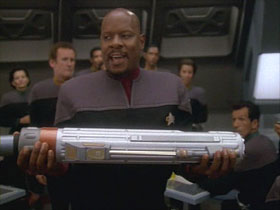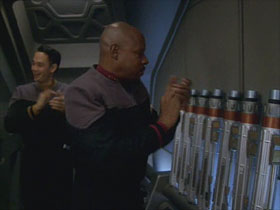DS9, considered by many to be the
most militaristic of the Trek series, shows strong
infantry weapons fairly consistently, but is inconsistent in its
treatment of
ship-grade weaponry. On one hand, ship-grade weaponry seems to be
little heavier than hand weapons;

on the
other, ship-grade weaponry - particularly torpedos - are also stated to
be powerful enough to destroy planets and moons.

There are
a few moderate references relating to ultritium, but even these are
difficult to adjust into a consistent scheme of yields.

Infantry weapons may have outputs into the gigawatt range regularly,
with heavy weapons firing multi-gigajoule shots. Autotargeting features
are present on Federation phaser rifles, although not on Cardassian
equipment.

Ranges demonstrated are likewise mixed; although the maximum range of
ship-grade weaponry clearly exceeds 100,000 km, it is common for
weapons to be fired at several kilometers or even several hundred
meters.

A variety of new weapons are seen. Of particular interest is the
introduction of cloaked minefields and the use of orbital weapons
platforms.


The
Defiant's phasers appear to be generally powered by large
man-portable batteries, but can also be run off of ship's power to the
tune of
"15% of plasma to
phaser banks" (
"For the
Uniform");
draining the phaser banks can
provide a 50% boost in speed. These two reference suggest an overall
output equal to 15-50% of
the Defiant's warp core output (i.e, hundreds of petawatts to exawatts.)

There are racks of
these
available at DS9, and it becomes quite common for a drained power pack
to be replaced after a mission. These two pictures are from
"Behind the Lines."
The cell appears roughly three feet long and 4-5 inches wide, making it
roughly 100-1000 times the size of hand phaser power pack.
If we assume the technology used is similar to that of hand phaser
power packs, then - depending on whether the batteries are recharged
and drained with each shot (eventually wearing out) or nonrechargable -
the figures from
"Return to Grace"
suggest 470 MJ to 16.4 TJ per shot. On a similar note, a satellite
building up to 600 and then 900 megawatts of
power
and then firing downed a Runabout's shields in one hit in
"Battle Lines." The total
amount of energy involved would appear to be on the general order of
gigajoules and no higher - i.e., not much higher than some hand
weapons'
power, as seen in
"Business as
Usual." See also the note on
hand weapon power.

Plasma
torpedos appear in DS9 several times; in every case, they appear
exceptionally powerful. Plasma torpedos are capable of outright
destroying a moon or
planet in
"The Die is Cast"
and
"Tears of the Prophets."
Romulan plasma torpedos contain trilithium, per
"Image in the Sand;" this helps
explain this degree of power.
In
"Broken Link," we are
told that
the Defiant alone - which we are generally led to assume carries
quantum and photon torpedos could turn the Founders'
homeworld
"into a cinder."
Curiously enough, Worf refers to photon torpedos having
"plasma warheads" in
"For the Uniform," although
"Sons of Mogh" indicates they
still emit gamma ray bursts, as we would expect from antimatter
warheads.
Quantum torpedos can be turned into long-term chemical
weapons by the addition of 200 kg of trilithium resin per torpedo (
"For the Uniform.") The Defiant
has at least 45 quantum torpedos, although this appears to be a low
figure reached late in battle (
"What
You Leave Behind").
"Valiant"
refers to quantum
torpedos having a
"maximum
yield," which means that quantum torpedos are
variable-yield.
In
"Trials and Tribble-ations,"
we learn the tribble homeworld was
"obliterated" by the
Klingon Empire. It is uncertain if this refers to physical obliteration
of the planet as planned for the Founders in
"The Die is Cast," or merely
wiping out everything living on the surface; we learn in another
episode that a Bird of Prey is unable to effectively target a
subterranean base (although a Vor'Cha cruiser is able to), which
would suggest that a physical deconstruction of the planet is probably
not what happened to the tribble homeworld.
"What You Leave Behind"
gives us another attack on planetside, although not of the incredibly
destructive variety. Instead, two million Cardassian citizens are dead
in
seconds, with at
least 800 million dead on Cardassia by the end of the episode.

Intermediate
levels of firepower may be drawn from
"Apocalypse Rising," in which we
learn a full spread of photon torpedos would destroy Ty'Gykor and
"everything within several hundred
kilometers." Similarly, a 90 isoton enriched ultritium
explosive would demolish an asteroid base and destroy everything within
800 kilometers in
"A Time to
Stand."
A gigaton explosion in empty space would apply roughly 500 kilojoules
per square meter at a range of 800 kilometers - almost enough to cook
frozen pizza in thermal terms, or about enough kinetically to send an
inch thick (2.54 cm) steel plate flying at ~160 mph (~255 kph). At 300
km, a gigaton explosion in empty space would apply ~3.6 megajoules per
square meter - enough to scorch a pizza, or send an inch-thick steel
plate
flying at mach 0.6. This would therefore
suggest, although not require, torpedo yields on the general order of
exajoules.
However, 10 isoton ultritium concussion shells can destroy an
unshielded ship
if they hit directly
in
"The Ship,"
but seem to have a limited effect on the surface. In order for this to
be a consistent use of "isoton" as a term denoting yield, the ultritium
concussion shells - if detonated underground - would release energy
comparable to a 7.0-7.5 Richter earthquake. Given also that a small
amount of ultritium resin in an earring has a 20 meter blast radius,
the ultritium explosives of
"A
Time to Stand" should contain several billion times as much
ultritium. If the earring contained a single cubic millimeter, then
four cubic meters of ultritium should have been involved in
"A Time to Stand."

In
"Crossover," a hand phaser
splatters Odo against the wall - a dramatic high-momentum effect, if
not as dramatic in energy terms as the vaporizations of normal
humanoids.
"Return to Grace"
gives us a very detailed look at two typical infantry weapons. A
standard Cardassian phase disruptor rifle has a
4.7 megajoule power capacity, a 3 millisecond recharge time, and two
beam settings; a Federation phaser rifle is a bit larger, a bit less
powerful, and has 16 beam settings, autonomous recharge,
gyrostabilization,
"multiple
target acquisition," and
other features.
Firing maximum power 4.7 megajoule shots at 20,000 rounds per minute (a
3 ms fire cycle)
compares very favorably with the GAU-8 rotary 30mm cannon (used on the
A-10 Warthog), which has a muzzle energy of 207 kilojoules and a peak
rate of
fire of 4200 rpm. The 24th century version of the AK-47 is therefore
over a hundred times as powerful as a late 20th/early 21st century
anti-tank weapon.
"Rocks and Shoals"
would appear to show the
"multiple
target acquisition" of Federation phaser rifles in
action. Sisko's men have
"phaser
locks" on the Jem'Hadar,
who outnumber them in able-bodied soldiers by two to one; this is a
decisive advantage, particularly combined with cover. After a brief
exchange of fire, all the Jem'Hadar
are dead.
"Business as Usual"
gives an example quite consistent with the above. The Breen CRM-114 is
a lightweight bazooka like weapon, rated to cut
through 6-15 cm reactive armor and up to 4.6 gigajoule shields. This
suggests shot energies in the multi-gigajoule range, which would
indicate a higher power level than a phase disruptor rifle.
"Wrongs Darker than Death or
Night" - an ultritium resin earring has a
20 meter blast radius. This is a small grenade by modern standards, but
not very remarkable as a weapon.
"Things Past" - a
chambered plasma grenade was used to attempt to assassinate
Gul Dukat during the occupation. This appears to be nothing exceptional.
"Blaze of Glory" -
duridium drums will hold off hand phaser fire for a
while. Contrastingly, crates of gold-pressed latinum in
"Who Mourns for Morn" will not
hold off any weapons fire.

In
"The Search" - 100,000
kilometers is
"well within range"
of the Jem'Hadar ships' weapons.
Cardassian system defense
disruptors have a range of over 200,000 kilometers; targeting sequences
may begin at 400,000-500,000 kilometers.
The Defiant's phaser beam may be adjusted to a width wide enough to
envelop an entire comet. A standard burst at 10 kilometers broke the
comet into three fragments, instead of evenly vaporizing it with a
widebeam burst.
"Once More Unto the Breach"
- cloaked, raiding BOPs close to three
hundred meters before firing.

We see
orbital weapons platforms most notably in
"What You Leave Behind" around
Cardassia Prime and also in
"Tears
of the Prophets." These are considered quite potent for
defensive purposes, which suggests that maneuverability is of
relatively limited importance in combat.


































